
Art is society’s visionary
An interview with the artistic director of CENTRALE for contemporary art Carine Fol
09/10/2018
The CENTRALE for contemporary art is a small, dynamic art institution founded in 2006 by the City of Brussels with the goal of giving contemporary visual arts the widest possible audience and helping people to discover contemporary artists from Brussels within an international perspective. The exhibition programme at the CENTRALE constantly surveys the borders of art and has initiated dialogues between all representatives from the different areas in the field, thus demonstrating the diversity of the local art scene. The CENTRALE has found a home in Brussels’ first power station (built in 1893), from which it also derives its name. It works closely with art schools in Belgium’s capital, and one of the centre’s priorities is participative art projects and cultural and social links with the city as a whole and it’s neighbourhood.
The RESISTANCE project, on show at the CENTRALE until January 27, 2019, marks the 50th anniversary of the protests of May 1968 and focuses on the ways in which art has used and pursued the many societal and political challenges that have rocked the past half-century. The exhibition includes artwork from the past, created in 1968, as well as work by modern-day Belgian and international artists. The events of May 1968 generated a feeling of floodgates breaking open in the world of art and society in general, and RESISTANCE accurately reflects this feeling as well as its echoes in the art of today. The Open Academy operates alongside the exhibition, at which teachers and students from the 4 main Art Schools of the city analyse the 1968 protests, their origins and the general body of causes that provoked protests back then and also today.

PRIVATE CHOICES. Installation view. Photo: Philippe De Gobert, Brussels
The previous exhibition at the CENTRALE, titled PRIVATE CHOICES (November 9, 2017 – May 27, 2018), also attracted much attention both locally and internationally. It presented artwork from the private collections of eleven Brussels-based art collectors representing various generations. Arterritory.com met with art historian Carine Fol, the artistic director of the CENTRALE and curator of PRIVATE CHOICES, to talk about the increasing role of the art collector in contemporary art and about how Brussels has emerged as one of Europe’s current centres of contemporary art. Before becoming CENTRALE’s art director in 2012, Fol spent ten years directing art & marges museum, an art centre now museum dedicated to outsider art. She has also collaborated with legendary curator Harald Szeemann.
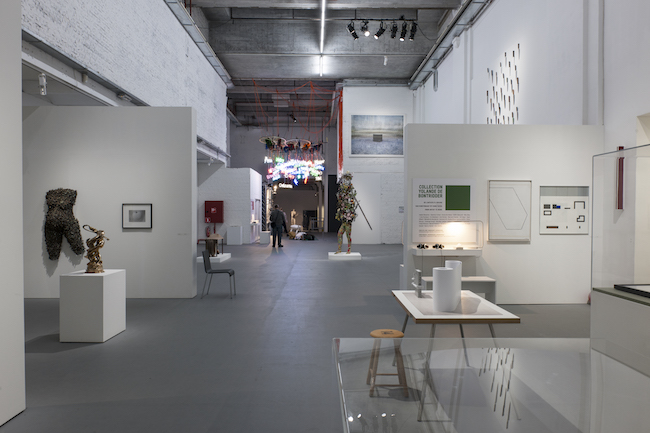
PRIVATE CHOICES. Installation view. Photo: Philippe De Gobert, Brussels
The PRIVATE CHOICES exhibition, organised by the CENTRALE for contemporary art and curated by yourself, became one of the loudest events on Brussels’ art scene late last year and at the beginning of this year, attracting 20,000 visitors. How did the idea for the exhibition come about, and how do you explain its success?
For me, it was very important to show that very individual way of looking at art as a contrast to the prevailing stereotype surrounding art collectors that they’re profiteers, that they mainly collect art as an investment, and so on. Each of the eleven collectors represented in the exhibition was allotted one space, where, in addition to artwork from their collections, visitors could listen to an interview with the collector. That gave the exhibition a more personal touch. I also asked the collectors to choose a book and a piece of music, because I wanted to show some of their interests outside of the contemporary art scene. So, it was an opportunity to go deeper into the personality of each collector.
Two exhibitions in Paris had left a great impression on me: Passions Privées at the City Museum of Modern Art in 1995, and L’intime: Le collectionneur derrière la porte (2004), initiated by art collector and director of the Maison Rouge art space Antoine de Galbert. The former displayed prominent works of art from private French collections, while the latter was set up to look like the inside of a collector’s house. So, it demonstrated not only the owner’s passion for art but also allowed visitors to look into the collector’s interaction with art on a daily basis.
Regarding the exhibition at the CENTRALE, it was very important for me that the collectors represented in it were as different from each other as possible. Not just in terms of their interests but also in terms of their ages and the budgets they devote to art. The collectors ranged in age from 40 to 70. In all, there were more than 200 works of art in the exhibition, some by renown artists, other by young or completely unknown artists. In a way, it reflected the current art scene in Brussels – its diversity and depth. But at the same time it also demonstrated how collectors collaborate in the development that art scene.
PRIVATE CHOICES was undeniably also the CENTRALE’s biggest project to date. It was very important for us for it gave us the opportunity to widen our audience and to become known by the part of the audience that are collectors. The CENTRALE is a contemporary art centre that was founded by the City of Brussels, whichmeans financed with public money. And I feel it as a necessary part of my role is to show local artists, and this from an international perspective.
Before I became the CENTRALE’s art director, I was the director of the museum of outsider art (Art et Marges Museum) for ten years. I did my PhD thesis about outsider art, and so for me it’s important to question these limits between what is art and what is recognised as art and what is not. In fact, everything I do comes from this humanistic view of art, more than just showing names or having huge exhibitions by important international artists. It’s a way of looking at art that is very connected with humans, with people. For me, this is very important.
For example, one of the collectors featured in the exhibition was a gardener who developed his collection together with his wife, but their interests do not always match. He’s very interested in surrealism and has lots of artwork by various artists all called Marcel (Marcel Duchamp, Marcel Mariën, Marcel Vandeweyer, etc.). I named his room the “Surrealistic Cabinet”, and in some way his collection proved that collecting does not necessarily mean huge investments and a big budget, and that pieces by internationally renowned artists can still be found in auction rooms at reasonable prices.
At the same time, the exhibition also included pieces from the collection of Frédéric de Goldschmidt, a French collector who is already quite well known in the art world. He has a very large collection, with artists known internationally as well as young artists. He began with work by the Zero artists’ group. When I met de Goldschmidt, what caught my attention was the distinct presence of the colour white in his collection. So, I decided to call his space the “Eulogy of White”, which coincided with Zero’s manifesto from 1960, which specified that the group’s name meant a silent area offering new possibilities rather than a nihilistic vision.
Among the collections in the exhibition, that of Christophe Veys was also very special. He’s a professor of Contemporary Art History, and he began his collection at age 20, while still a student. Unlike most collectors, he has never lived together with the artwork in his collection, and he likes to define it as “invisible”. It’s also invisible for him because it consists of very conceptual works of art, which are not always aesthetic or very visible. For example, there was a piece by the Dutch artist duo “gerlach en koop”, which was just a paper clip. As his favourite book, Veys chose The Invisible Collection by Stefan Zweig, which also inspired the name of his presentation. But the most interesting thing is that, contrary to his own assertion that a collector is like a “shy ambassador”, Veys honoured the exhibition at least three times a week with his presence, telling visitors about the artwork in his collection. It was kind of a performance. The official name of the collection is Collection Veys-Verhaevert, and that also has a story behind it. Verhaevert was a partner of his, but they split up because Christophe was putting all of his money into his collection. He was ruining himself for the passion of art.
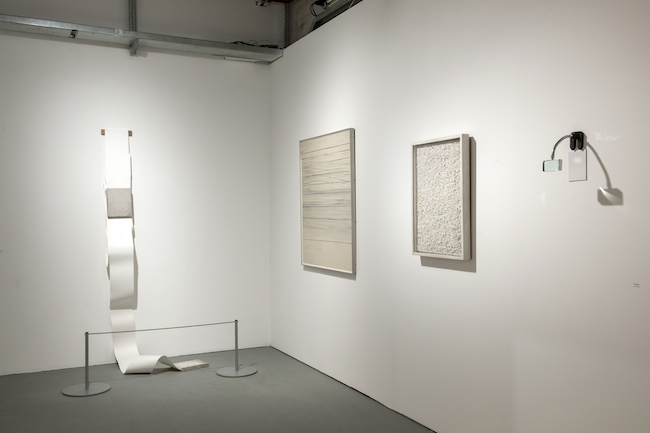
PRIVATE CHOICES. Installation view. Photo: Philippe De Gobert, Brussels
The collectors’ scene in Belgium is particularly strong. Also in a historical sense. It is undoubtedly stronger than that in, for example, France. How do you explain that?
In 2014, when the CENTRALE hosted the 15th anniversary exhibition for the Marcel Duchamp Prize, established in Paris, we organised a colloquium with Belgian and French collectors. One of the things that became clear in these discussions was that in Belgium we’ve never had this importance of politics and official institutions in supporting art. It has always mostly been private individuals who have felt the necessity to help artists and institutions. Unlike France, where you don’t have so many collectors, indeed, because you have these huge museums. That was one of the explanations. It’s a kind of passion for Belgians – and more in the Flemish part of the country than in the French part. And that’s been going on for generations on end, and what’s interesting is that in most cases the choices made by Belgian collectors are very intelligent and smart. Many young artists noticed by Belgian art collectors have gone on to become notable artists.
In Belgian private collections you also get a very strong feeling of the collector’s personality. It’s not always like this. There are always some collectors who try to be more or less on the safe side with their choices, but with Belgians, you feel that they’re not afraid, nor are they afraid of their choices. That’s a very interesting aspect as well.
Yes, they really take risks. Of course, you cannot generalise – there are some collectors who are more mainstream, and then there are the others.
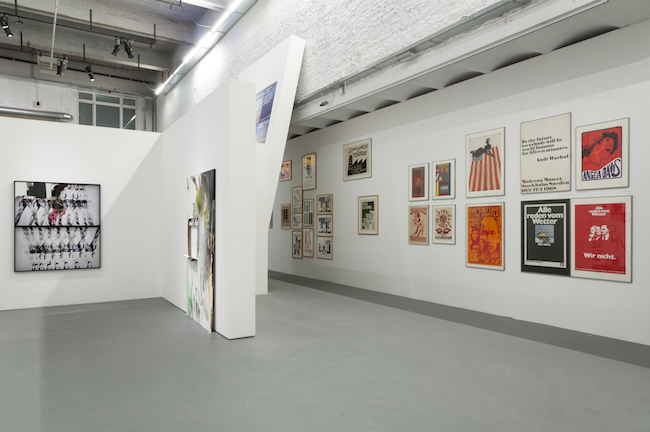
RESISTANCE. Installation view. Photo: Sébastien Reuzé
The youngest collectors in the exhibition were 40-year-olds. What’s your opinion – is the younger generation continuing the tradition of collecting art as enthusiastically as the generations before them?
Yes, sure. I’m preparing a second project about collections with the Belgian artist Patrick Corillon,who has already worked with several museums about the idea and the concept of collections. Unlike this exhibition, it will not be only about private collections but also about public ones, with the idea of how does your view, your conception of art, make an evolution. For example, when he is young and still in art school, an artist goes to the museum and sees a work of art, and he says, “Wow, it’s in a museum”. Then he makes his career, his work is represented in private collections, and later on this private collection is given to the museum. For him, it’s a kind of circle. This exhibition is a really big project that will involve not only the CENTRALE but also other art institutions. It’s planned to open in 2021 or 2022.
Right now, Brussels is one of the centres on the international contemporary art scene. And collectors play a very significant role in that. Also in terms of public and private partnerships – on the broadest spectrum of levels. Working at the CENTRALE, it’s very important for me to also secure the link with the city itself, with the people who live here, with different levels of society. So, I give a lot of importance to projects like Le Grand BanKet (2016) by Françoise Schein, in which – to celebrate the CENTRALE’s tenth anniversary – we set up ten tables right here in the neighbourhood, at Place Sainte-Catherine, where people can sit down and enjoy some food together.
For me, it was important to make that project because, first of all, people who would not otherwise come to a contemporary art centre by themselves came to the CENTRALE because of that project. And secondly, this work of art was exhibited in the urban environment, and it has now been adopted by the people of Brussels and by international visitors as well. So, the work of art becomes a place of contact, and that is also very interesting. An interesting evolution, in fact.
For about 10 years now, I’m on a committee that makes decisions about setting up artwork in the urban environment. Like in every city and in every country, very often there are things that are related to politics. For example, people who want to display a certain artist that we as a committee don’t find interesting artistically, and so sometimes it’s difficult. But it’s like that everywhere. I think we can be proud of the integration we’ve done here in Brussels (Daniel Buren, Wim Delvoye, Peter Downsbrough, …). We’re making a publication now and developing a walk in Brussels that goes to all of these places with public artwork, and the CENTRALE will be the place where you can get this publication.
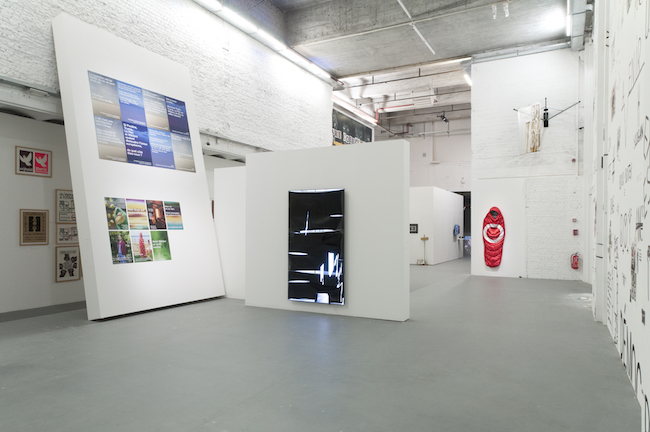
RESISTANCE. Installation view. Photo: Sébastien Reuzé
You said that Brussels has become an important centre for contemporary art. What do you think are the reasons for why the city has been able to do this?
I think what really makes Brussels special is the fact that there are very many different levels of cultural spaces here. You have WIELS, which is a very important actor, of course. But in the meantime, the CENTRALE also has a strong identity, which is very different from that of WIELS. And you can see the huge evolution of BOZAR in recent years. More and more new galleries are opening, too, and they appreciate the dynamism of Brussels’ art scene. And I think collectors also play a role. Because they are more and more important on the art scene now. It wasn’t like that before.
There are two sides to that, of course.
Of course, but they’re playing more and more of a role. People like Alain Servais or Walter Vanhaerents. They’re people who give an international character to Brussels, because they’re everywhere and because interest in collectors is only increasing. I think the specificity of Brussels is its diversity. You don’t have the same in Paris, for example. It’s a totally different landscape here. And you have a kind of freedom in Brussels, also in the art scene. And that’s maybe due to the Belgian and Brussels character.

PRIVATE CHOICES. Installation view. Photo: Philippe De Gobert, Brussels
How did the idea of the CENTRALE begin, and how do you see its role on the current art scene in Brussels?
The CENTRALE exist for twelve years now. I’ve been here for six years. In fact, the idea came from the City of Brussels. They knew this site, and they were thinking that it could be interesting to open a contemporary art centre here. In the beginning, the CENTRALE didn’t produce exhibitions. When I arrived, I really wanted to give an identity to this place and I thought that this identity should be connected with Brussels and with the Brussels’ art scene in an international perspective. Because nowadays art isn’t local anymore; everything is all over the world.
Of course, we’re still small – just 1000 square metres – and also budget-wise we’re not on the same level as WIELS for example. But I think we have a role to play here in Brussels, and I feel that it’s increasing. For instance, we just opened a project called RESISTANCE in which I created a collaboration between the 4 main Brussels’ Art Schools in the form of an Open Academy. So, the CENTRALE will be partly a laboratory for two French and two Flemish art schools in Brussels, where students will come together and there will be conferences, lectures, etc. I think that is also our role, and we can take that risk.
I always want to re-question the art scene, and I think the dialogue with art schools is very important in that regard. Here at the CENTRALE we also have the CENTRALE.box, which is for young artists, and we have the CENTRALE.lab, which is a little place for artists younger than 35 years old. And that’s an opportunity – they receive a 1000-euro grant to make a solo exhibition. We receive the applications, and a jury selects the artists. So, that’s also the role of the city and the CENTRALE – to support younger artists from different origins who live and work in Brussels.
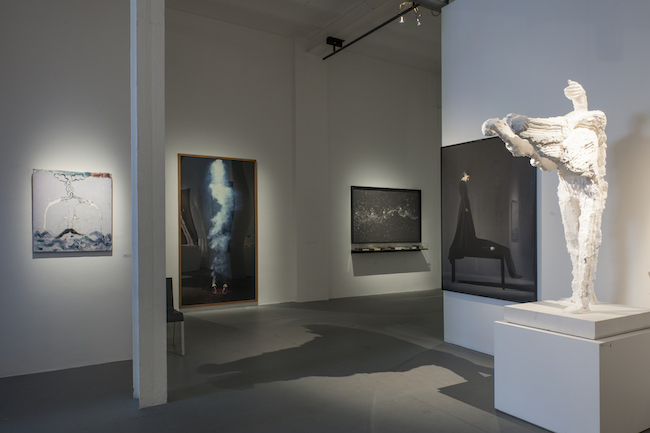
PRIVATE CHOICES. Installation view. Photo: Philippe De Gobert, Brussels
Returning to collecting. We spoke about the growing importance of the collector, but how do you see the collector’s responsibility?
I think being a collector is a very huge responsibility, especially because they take risk. Collectors nowadays are much freer than museum directors. They can take more risks, and that’s also a way of opening some pathways, some directions, that museum directors can’t open. And that’s their role, I think. To be able to sustain artists who are not so well known and to help them to get into museums and become a part of the scene.
That’s why it’s interesting to follow collectors like Frédéric de Goldschmidt, Alain Servais or others who go to art schools and buy work by these young creators who are not really artists yet. This is somehow different than what a museum director can do. The museum director has to form a collection based on a scientific concept and importance. In the meantime, collectors have that freedom, and I think that this freedom is the tool for that risk and for that opening of the art world internationally. I remember Jan Hoet (the Belgian founder of SMAK [Stedelijk Museum voor Actuele Kunst, or the Municipal Museum for Contemporary Art] in Ghent – Ed.) said to me some years ago, just before he died, that private collectors now have a more important role than museum directors. Also because institutions have less money, and collectors have more money. It’s totally turning around. And he was critical and positive about that. He was negative about the fact that these people have that power.
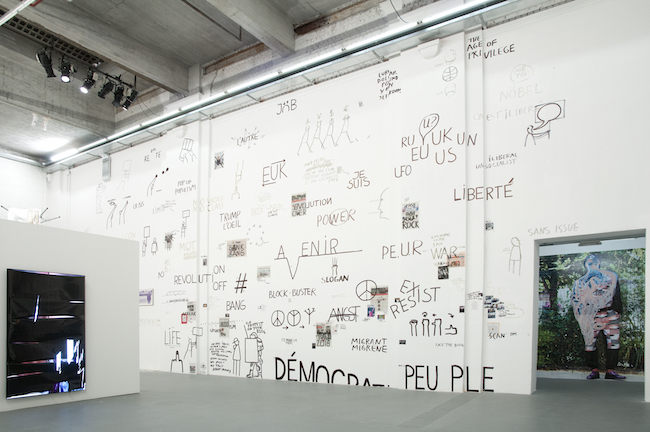
RESISTANCE. Installation view. Photo: Sébastien Reuzé
Because they can ruin young artists’ careers...
Yes, but a museum director can do that, too. And Hoet did it with a fewunfortunates. I think it’s the personalities, the way how you profile yourself in the art world. At the same time, you have these different actors, so, it’s a balance. Sometimes institutions and galleries are more important, sometimes collectors are more important – there’s an equilibrium between all of these things. And people like [François] Pinault, they’re totally changing the art world now. We’re going back a little to the times of the Renaissance, when the people who had the money were in fact running the world.
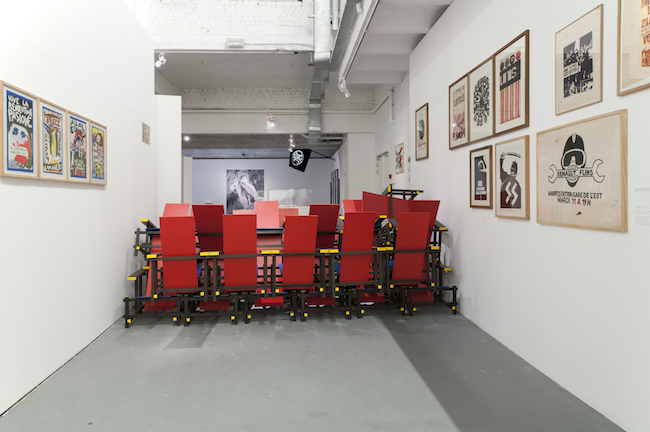
RESISTANCE. Installation view. Photo: Sébastien Reuzé
Right now, very many artists are coming out with political statements, taking a stand on various social or environmental issues. What do you think – also considering the CENTRALE’s experience with art in the public space – does art have the power to change people and/or society?
I really believe that art can change mentalities. Also now, in this new society with social media, the danger is that some things are very superficial and they are not rooted in scientific proof. But I think art has always had this ability, even before everything – in a visionary way. I think art is visionary about society, about our evolution in this world. That’s the power of art and the power of the artist. And that’s why I’m so passionate about art, because it gives you another perspective.
Sometimes that perspective is negative, but there’s also a perspective of hope. The possibility to change things. The RESISTANCE exhibition, which is currently on view at the CENTRALE, shows that as well. For example, the Guerrilla Girls – what they did was to evolve the way we look at women in the art world. It was an evolution, and they played a role in that.
Performance is becoming more and more important, too. The way we look at a work of art is changing, and also the connection between the artist and the viewer is changing. Now, the artist is no longer on the pedestal and the viewer somewhere out there – that’s also a very huge evolution.
Art helps society grow. I think it’s very important that every individual has the opportunity to have that connection with an artist and a work of art. That’s a freedom we all have. It’s a richness; it gives a different dimension to your life. It gives you the possibility to see things in another way. Sometimes it’s very confronting. But for me, art is something that is very true. Very intense and true.
.jpg)
Carine Fol. Photo: Saksia Vanderstichelen